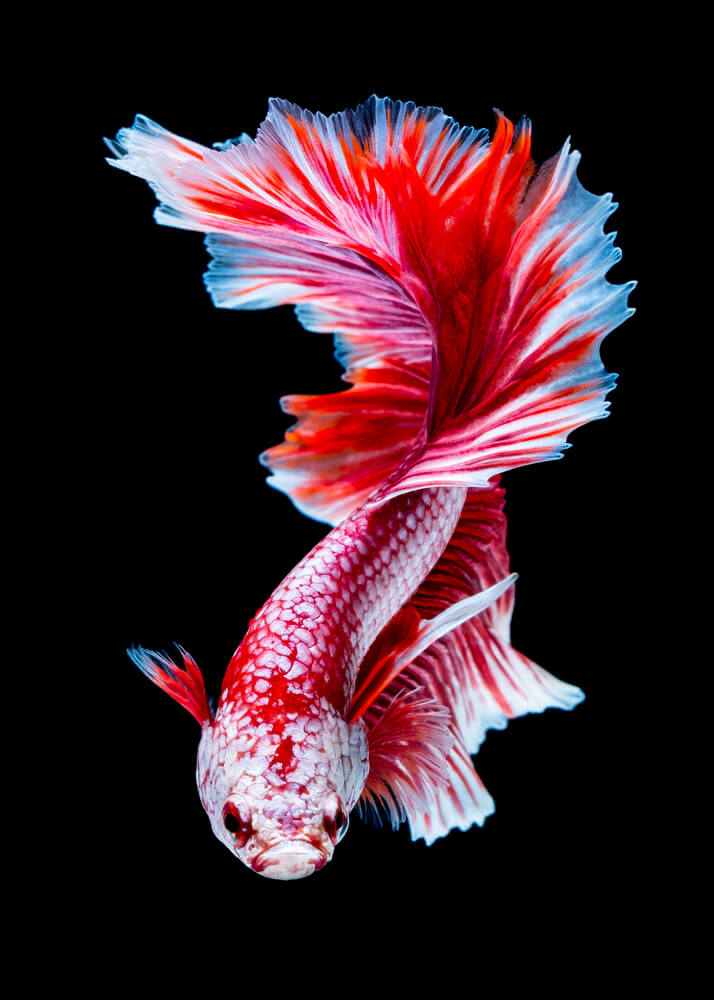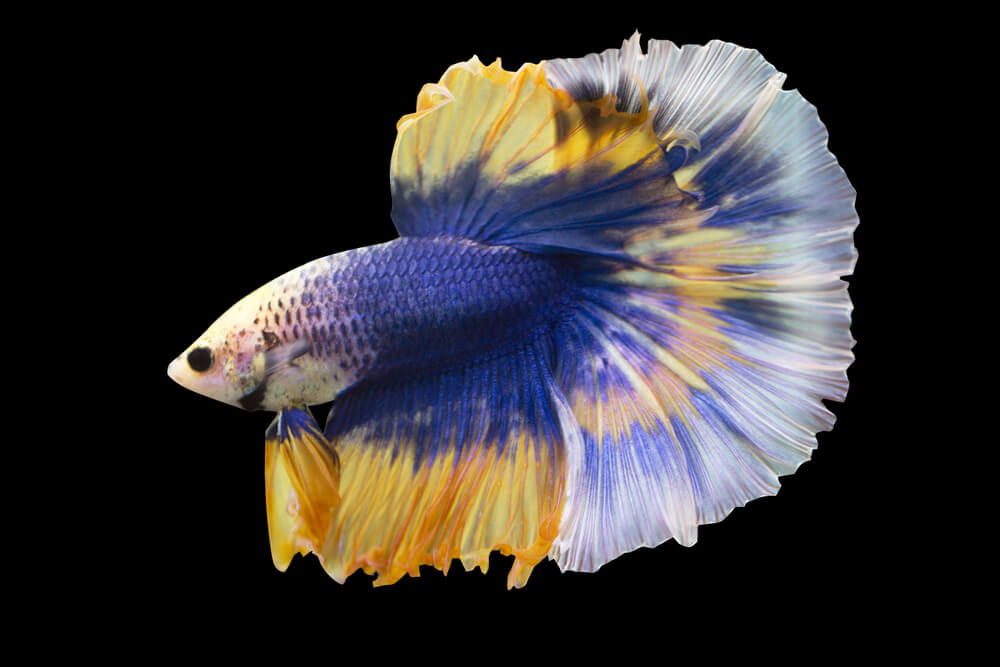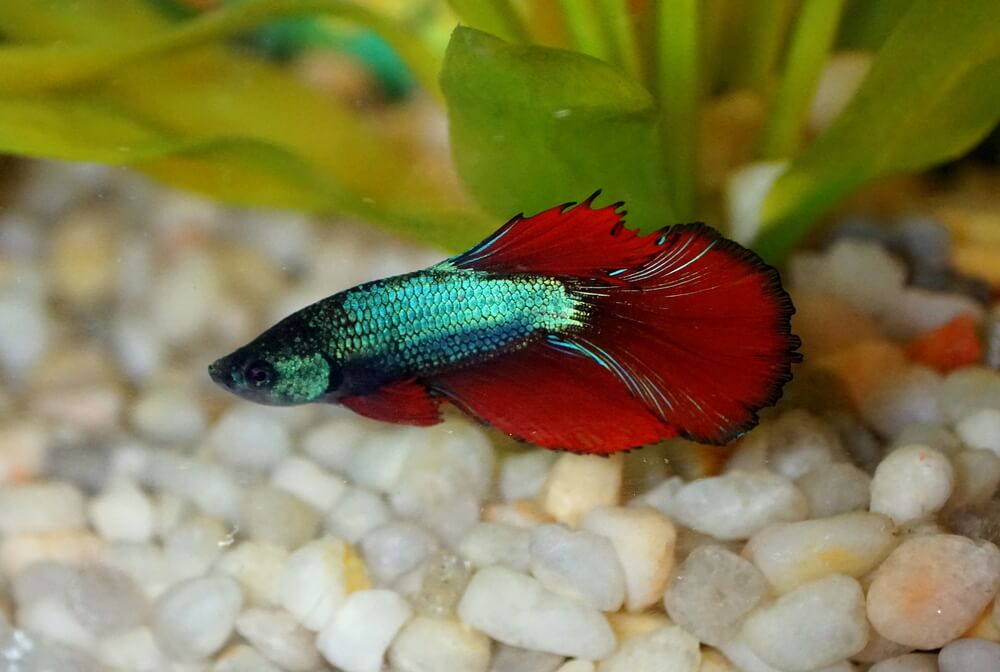Betta fish are some of the most popular aquarium inhabitants. Their bright colors, intricate fins and playful personalities make them a favorite of both experienced aquarists and beginners alike.
But did you know that betta fish can actually change color? The ability to shift their coloring is just one more way these beautiful creatures amaze us!
In this article, we will explore what causes betta fish to change color, how they do it and why it matters. So keep reading to learn all about this incredible aquatic species!

What Causes Betta Fish to Change Color?
Betta fish are known for their vibrant colors and they can change color depending on the environment, food supply, and other factors. This ability to adjust their hue is part of what makes them so popular in home aquariums.
But why do betta fish change color? The answer lies in a few different areas:
Health: A betta’s health often affects its coloring. If a betta isn’t feeling well or has an infection, it may become paler or darker than usual. Stress can also cause a betta’s color to change as it tries to hide from predators by blending into its surroundings.
Hormones: Hormones play an important role in color change for bettas. When male bettas detect another nearby male or female during breeding season, they will become more brightly colored as part of their natural courtship behavior. Females also experience hormonal-based coloring when ready to breed; however it is much less dramatic than that of males since females generally have duller colors overall.
Emotions: Betta fish have been found to show signs of emotion through changes in coloration. When excited or angry, a betta will darken its body and fins — this is thought to be used as either an intimidation tactic or as a way of showing aggression towards another fish.
Stress levels may result in a loss of vibrancy in their normally colorful scales while age and diet contribute greatly to hue variation too.
Additionally, when feeling relaxed or contented, some species of bettas will lighten up in color.
Environment: Betta fish can adjust their color according to the environment around them — this helps them better blend into their surroundings and stay hidden from potential predators lurking nearby. It’s important to note that most environmental changes won’t cause drastic variations in color; rather, only subtle adjustments will occur such as changing between shades of red or blue hues instead of green ones entirely.
Understanding why these colorful creatures alter their appearance gives us insight into how they interact with each other and the world around them. Whether expressing emotions, protecting themselves from danger, or simply trying to adapt to their habitat – we now know that there are many reasons behind why our beloved bettas change colour!

How Do Betta Fish Change Color?
As the light of day slowly fades from view, you may think that your betta fish is fading too. But no—as night descends, something magical happens. Your formerly bright and vibrant pet now changes color to a deep blue or black as if it has been cloaked in a veil of mystery.
This transformation can be attributed to special cells located beneath the scales on their skin called chromatophores which are filled with different colored pigments like carotenoids and melanin.
As the lights dim, these pigments are released creating an amazing display of color change. Depending on the type of pigment being released, a betta will turn yellow, orange, red or shades of browns and blues.
Experiencing this phenomenon firsthand gives you insight into how truly remarkable nature really is; when exposed to darkness our betta finds comfort in its ability to adapt by changing its hue right before our eyes!

Factors That Affect Betta Coloration
The color of a betta fish is determined by many factors, including genetics and environment. Genetics plays an important role in the beautiful colors that can be seen on these vibrantly colored creatures. The genetic makeup of a betta determines what shades they may have access to, such as reds, blues, greens, yellows and even purples.
Environmental influences also play a significant factor in determining how brightly or vividly a betta will appear. Factors such as water temperature, light levels, diet and stressors can all affect the intensity of their colors.
Bettas are capable of changing their color depending on circumstances surrounding them. For example, when confronted with another aggressive male or female fish they tend to become darker in order to display dominance or aggression towards it’s competitor. Similarly during breeding season males often develop more intense colours than usual due to hormonal changes associated with this period. Bettas can also change colour if exposed to different environments like colder temperatures which results in duller hues for instance.
In addition to environmental influences there is evidence that suggest some species are able morph into other forms over time in response to certain stimuli such as temperature variations or food availability. These drastic changes usually take place slowly over long periods of time but could potentially alter its natural colouring dramatically should conditions remain consistent enough for an extended amount of time.
Although not much is known about why some species undergo such changes we do know that it occurs frequently among wild populations around the world making the study of these incredible animals that much more fascinating!

How Common Is Color Changing In Betta Fish?
Betta fish are known for their vibrant colors, with some being able to change color in different situations. This phenomenon can be seen as a metaphor for the way we humans often alter our behavior based on external circumstances.
However, how common is this ability among bettas? It turns out that not all betta fish have the ability to change color, but those who do typically display more striking and intense hues.
The capacity of certain species of betta fish to change their coloring is believed by many experts to be an evolutionary adaptation designed to help them blend into their environment and thus avoid danger or capture prey easier. By changing its hue, a betta can better camouflage itself from potential predators while also helping it find food sources quicker.
Additionally, they may use color changes to show aggression towards other females during mating season or when feeling threatened. Though these colorful creatures famously embrace transformation, it’s important to remember that each individual betta has unique characteristics and personalities which dictate their behaviors—including whether or not they possess the special skill of altering their appearance through shifting shades.
Whether you own one of these fascinating aquatic animals or just admire them from afar, understanding what makes them so remarkable will bring about a greater appreciation for these beloved pets!
Strategies To Enhance Color Changes In Betta Fish
It’s no secret that betta fish can be incredibly colorful and vibrant. But what many people don’t know is just how often these beautiful creatures change color.
Here’s a look at some of the top methods for making your betta dazzle:
- Provide plenty of hiding spots – Betta fish derive comfort from having places to hide away when they feel stressed or threatened. Make sure there’s ample natural vegetation in the tank so they have somewhere to go if they get scared.
- Create different light sources – By providing multiple types of lighting, you can create an environment that stimulates the bettas’ color-changing abilities. Try to mix daylight bulbs with blue LED lights and even ultraviolet lamps if possible.
- Offer varied nutrition – Quality food makes all the difference when it comes to maintaining healthy colors in any animal, including bettas. Feed them fresh vegetables like zucchini, spinach, and peas as well as high-grade pellets designed specifically for their species.
With these tips in mind, you’ll be able to provide your betta with everything it needs to show off its best colors–and maybe even surprise you with something new every now and then! A little bit of effort goes a long way towards bringing out the beauty within these majestic creatures; try using one or two of these ideas today and see what happens!

Conclusion
It’s clear that betta fish can be mesmerizing with their ability to change color.
It’s quite incredible how they are able to alter their coloring based on the environment and stress levels.
With proper care, we can make sure our betta fish look as vibrant and beautiful as possible.
We should also never forget that these creatures have feelings too, so it’s important to provide them with a loving home in order for them to thrive.
